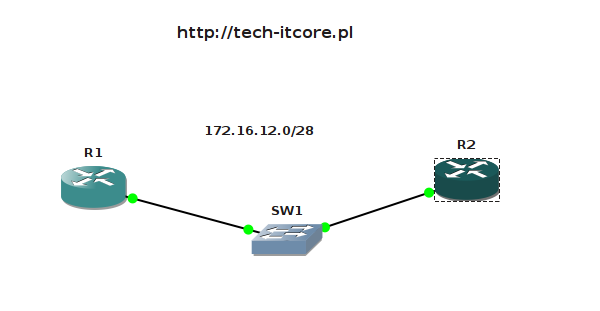Cele:
- Skonfiguruj RIP version 2 na wszystkich routerach. Upewnij się, że możesz pingować interfejsy Loopback0 z wszystkich routerów.
- Router R2 blokuje cały ruch multicast adresowany do sieci 224.0.0.0/4.
- Zmień konfigurację na R1 tak, żeby R2 nauczył się sieci 1.1.1.0/24 przez protokół RIP.
Adresy IP routerów:
R1
| Interfejs | IP |
|---|---|
| FastEthernet 0/0 | 172.16.12.1/28 |
| Loopback 0 | 1.1.1.1/24 |
R2
| Interfejs | IP |
|---|---|
| FastEthernet 0/0 | 172.16.12.2/28 |
| Loopback 0 | 2.2.2.2/24 |
Schemat sieci:
Router: 3640
IOS: c3640-jk9o3s-mz.124-16a.bin
Rozwiązanie
Skonfiguruj RIP version 2 na wszystkich routerach. Upewnij się, że możesz pingować interfejsy Loopback0 z wszystkich routerów.
Włączymy obsługę RIPv2 na wszystkich routerach oraz rozgłosimy wszystkie podłączone podsieci:
R1(config)#router rip R1(config-router)#version 2 R1(config-router)#no auto-summary R1(config-router)#network 0.0.0.0
R2(config)#router rip R2(config-router)#version 2 R2(config-router)#no auto-summary R2(config-router)#network 0.0.0.0
Sprawdzimy tablice routingu dla R1
R1#show ip route | begin Gateway
Gateway of last resort is not set
1.0.0.0/24 is subnetted, 1 subnets
C 1.1.1.0 is directly connected, Loopback0
2.0.0.0/24 is subnetted, 1 subnets
R 2.2.2.0 [120/1] via 172.16.12.2, 00:00:23, FastEthernet0/0
172.16.0.0/28 is subnetted, 1 subnets
C 172.16.12.0 is directly connected, FastEthernet0/0
Upewnijmy się że mamy łączność pingując interfejs Loopback 0 routera R2:
R1#ping 2.2.2.2 Type escape sequence to abort. Sending 5, 100-byte ICMP Echos to 2.2.2.2, timeout is 2 seconds: !!!!! Success rate is 100 percent (5/5), round-trip min/avg/max = 16/19/24 ms
Router R2 blokuje cały ruch multicast adresowany do sieci 224.0.0.0/4.
Na routerze R2 zdefiniowaliśmy listę dostępu, która blokuje wszystkie pakiety kierowane do sieci 224.0.0.0/4:
R2(config)#ip access-list extended 100 R2(config-ext-nacl)#10 deny ip any 224.0.0.0 15.255.255.255 log R2(config-ext-nacl)#20 permit ip any any
R2(config)#int f0/0 R2(config-if)#ip access-group 100 in
Oznacza to, że router R2 blokuje aktualizacje RIP wysyłane z routera R1 na adres multicastowy 224.0.0.9:
*Mar 1 00:26:00.615: %SEC-6-IPACCESSLOGP: list 100 denied udp 172.16.12.1(0) -> 224.0.0.9(0), 13 packets
R2#show ip access-lists
Extended IP access list 100
10 deny ip any 224.0.0.0 15.255.255.255 log (37 matches)
20 permit ip any any
Wynikiem tego jest brak wpisów dotyczących sieci 1.1.1.0/24 w tablicy routingu:
R2#show ip route | begin Gateway
Gateway of last resort is not set
2.0.0.0/24 is subnetted, 1 subnets
C 2.2.2.0 is directly connected, Loopback0
172.16.0.0/28 is subnetted, 1 subnets
C 172.16.12.0 is directly connected, FastEthernet0/0
Zmień konfigurację na R1 tak, żeby R2 nauczył się sieci 1.1.1.0/24 przez protokół RIP.
Naszym zadaniem jest zmiana konfiguracji RIP na routerze R1 tak, aby aktualizacje były wysłane na adres unicastowy routera R2. Służy do tego polecenie neighbor w trybie konfiguracji RIP:
R1(config)#router rip R1(config-router)#neighbor 172.16.12.2
Włączymy debug ip rip na routerze R2:
R2#debug ip rip RIP protocol debugging is on *Mar 1 00:32:49.283: RIP: received v2 update from 172.16.12.1 on FastEthernet0/0 *Mar 1 00:32:49.283: 1.1.1.0/24 via 0.0.0.0 in 1 hops
Widzimy, że router otrzymał aktualizację tras bezpośrednio na adres 172.16.12.1, zamiast jak poprzednio 224.0.0.9. Dzięki temu sieć 1.1.1.0/24 pojawia się w tablicy routingu:
R2#show ip route | begin Gateway
Gateway of last resort is not set
1.0.0.0/24 is subnetted, 1 subnets
R 1.1.1.0 [120/1] via 172.16.12.1, 00:00:22, FastEthernet0/0
2.0.0.0/24 is subnetted, 1 subnets
C 2.2.2.0 is directly connected, Loopback0
172.16.0.0/28 is subnetted, 1 subnets
C 172.16.12.0 is directly connected, FastEthernet0/
Polecenie ping:
R2#ping 1.1.1.1 Type escape sequence to abort. Sending 5, 100-byte ICMP Echos to 1.1.1.1, timeout is 2 seconds: !!!!! Success rate is 100 percent (5/5), round-trip min/avg/max = 12/18/28 ms


0 Komentarze.